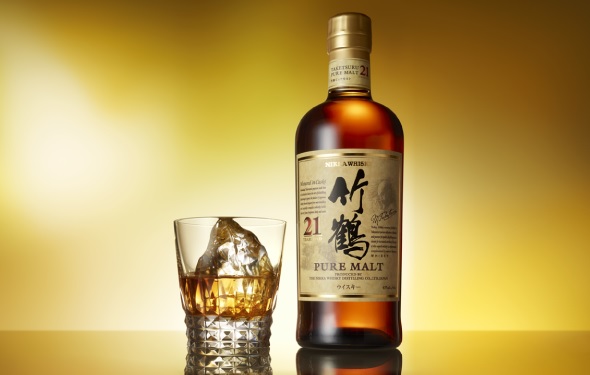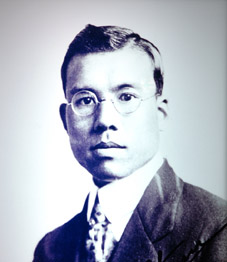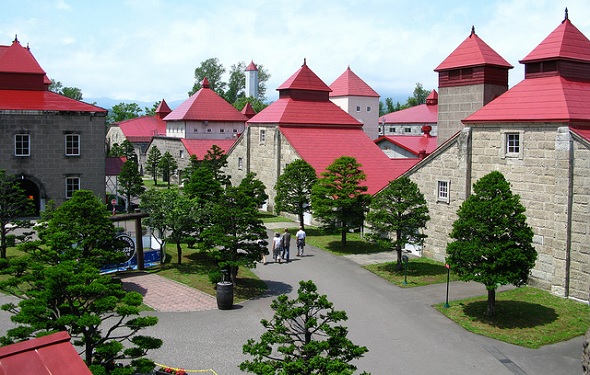This is part five of our ongoing series on Japanese whisky. To get started, see:
Part One | An Intro to Japanese Whisky
Part Two | Suntory: The Japanese Whisky that Started it All
Part Three | Hakushu 12 Year Japanese Whisky Review
Part Four | Yamazaki 18 Year Japanese Whisky Review
We’ve spent time detailing the origins of Suntory, the beverage giant that pioneered Japanese whisky and introduced it to the Western world. Its founder, Shinjiro Torii, established a capitalist legacy of reactive fluidity where consumer palate and modern technique solved for x (whisky). Think of him—and his crossover success—like the Bruce Lee of the spirits world. But now let’s look at a figurehead who was, by contrast, both a sensitive artist and uncompromising laborer. One whose passion was not profitability, but the perfection of his individual craft and the effect it had on the world around him. I’m speaking of Masataka Taketsuru.
Taketsuru was born the third son of a sake brewer in Takehara, Hiroshima in 1894. From a young age, his future seemed decided. It was expected that he take over the family business after he came of age, as neither of his older brothers showed particular interest in sake. Taketsuru’s father enrolled him in courses on sake and the various styles of production, and gave him hands on experience at the brewery. It would have been quite easy for the sharp witted young man to apply himself to his studies, graduate to work at his father’s brewery, follow that course into ownership of a respectable sake brand and live out his days making good sake. But Taketsuru couldn’t be satisfied within the confines of the scope of his studies, and he developed an extracurricular interest in Western spirits, particularly Scotch whiskies.
In her book, Japanese Whisky, Scotch Blend, Olive Checkland writes that “by 1912, when the Meiji Emperor died, there were several companies manufacturing [foreign] spirits,” including Kanseido, Denbei Kamiya and Nishikawa. So at this point, whisky had been a Japanese import for four decades, and the Japanese had been hard at work trying to understand and replicate the spirit, to little success. In timely fashion, Taketsuru gets sent to Scotland to further his education on the dime of major liquor company, Settsu Shuzo, with the express intention of studying organic chemistry and the process of Western whisky production. While other companies had been trying to reverse engineer many centuries’ worth of whisky-making tradition, Settsu Shuzo owner Kihei Abe decided to go straight to the source. So he sent the bright, young Taketsuru to Scotland after recruiting him only three years prior from Osaka Technical High School.
His efforts had less than the desired effect, but not for lack of trying. Nettleton’s fees were simply too much. Between room and board, education and hands on training, Nettleton was essentially asking for six times Taketsuru’s salary, at a time when student loans were not a possibility for a foreign young man. Not about to return to the classroom to dawdle away the remainder of his time in Scotland, Taketsuru found a map of Speyside Scotch distilleries and began banging on doors. After a few tries, Taketsuru got his first break at the Longmorn Distillery. Longmorn’s general manager, J.R. Grant, seemingly pleased with an opportunity to share his knowledge with a foreign enthusiast, allowed him to apprentice for five days.
Taketsuru had found a chink in the armor. On returning from Longmorn, Taketsuru wrote in his diary: “… arriving in Glasgow early in the evening, although it was smoky, I felt I was at home, and that Glasgow is my town.” I imagine him stepping off the train into April weather that rarely broke 50°F, out of alien territory and onto his battlefield. He would go on to secure apprenticeship at the Bo’ness distillery, where he would gain experience with grain whisky production on a Coffey still (common practice for blends), and perhaps most importantly, a five month stint at the Campbeltown Hazelburn distillery, where his friendships with his chemistry professor and distillery managers led him to volumes of knowledge about the Scotch whisky tradition. Taketsuru’s thirst and work ethic extended beyond the reach of scholarly pursuits, and he eventually returned to Japan with knowledge of Scotch whisky production and a Scottish wife.
The following fourteen years are well documented, in this series and elsewhere. Taketsuru experienced a slew of critical disappointments on returning to Japan as his romantic ideals and single-minded intensity prevented him from rejoining the ranks for any lasting period of time. No matter how hard he worked, he couldn’t seem to find himself among company that was driven by a desire to create great spirits first, and great profits as a result. Then a few months after leaving Kotobukiya (later to become Suntory), the innovative Taketsuru convinced investors to build a fruit juice plant under the name Dainipponkaju Co., Ltd. (which translates to “The Great Japanese Juice Company”) in the remote island region of Hokkaido. Incidentally, it had a climate, altitude, and proximity to the sea suspiciously similar to that of Scotland, as well as ready access to clean water, barley and grain. Clever guy, that Taketsuru. So while the apple juice business plodded along, Taketsuru used his surroundings and equipment to begin making whisky and, at long last, announced the opening of the Yoichi distillery. Six years of maturation later, Nikka Whisky was released. A juice company consistently in the red suddenly became a whisky-making cash cow, even in the midst of war. Taketsuru brokered a deal with the Japanese government (which at this point had been embroiled in the Second Sino-Japanese War for over three years) to classify Nikka Whisky as a war resource, garnering it preferred access to increasingly rare barley resources.
Thirty five years later, Taketsuru and team would open a second distillery in Miyagikyo, and Taketsuru would oversee Nikka’s operations until his passing in 1979 at the age of 85. His legacy would grow to rival that of Shinjiro Torii’s, whose capitalist approach to whisky production he had fought to counterbalance in his lifetime.
Toward the end of his life, Taketsuru said of whisky production: “We can’t make good whisky on our own, but we can help nature to raise good whisky. And our aim is to transcribe the taste of nature.” I could write volumes on this statement alone. Here’s the Walter White of Japanese whisky saying the quality of his work is largely beyond his control. Consider the greater context of what he’s saying. His role is not to give people the whisky they want to drink, but to use his talents to refine a timeless tapestry with the contribution of his thread. To Taketsuru, whisky was untamable. It was a force of nature, and he was a lightning rod. And for a majestic moment, he channeled that dynamo into a bottle named Nikka.





